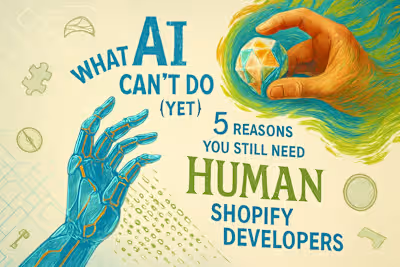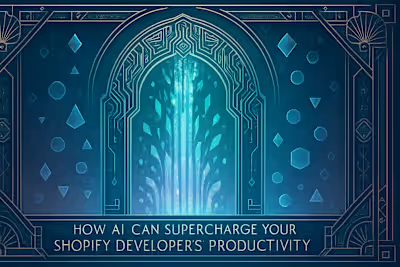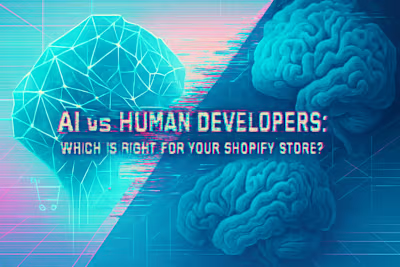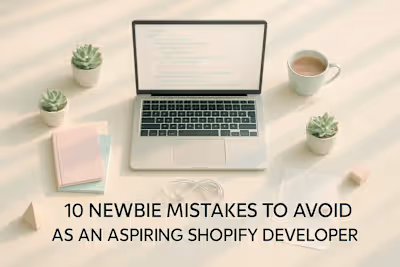Don’t Get Left Behind: 3 AI Trends in Shopify Development for 2025
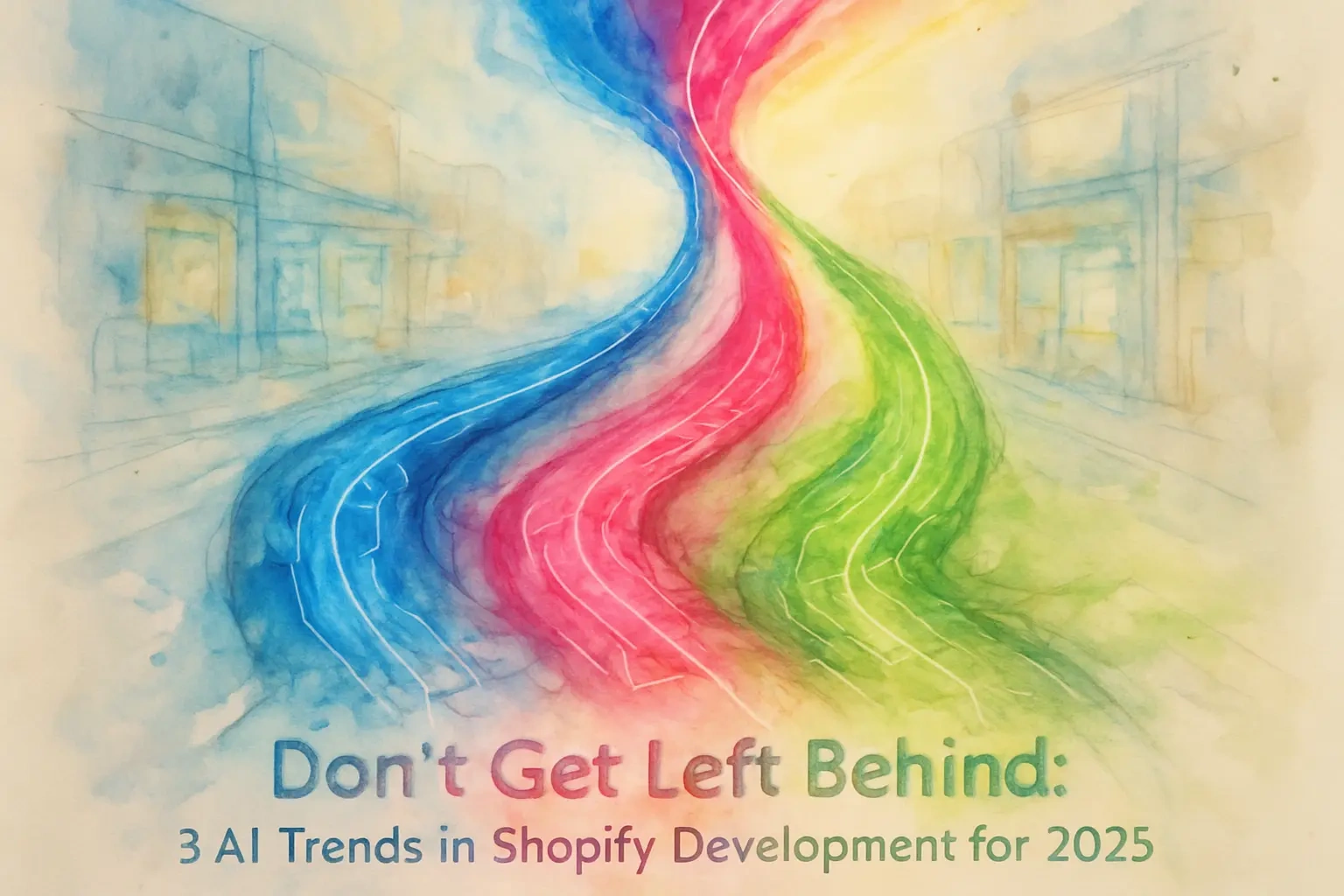
Don't Get Left Behind: 3 AI Trends in Shopify Development for 2025
Trend 1: Hyper-Personalization at Scale
AI-Powered Dynamic User Journeys
Context-Aware Product Recommendations
Trend 2: Predictive Analytics for Operations and Marketing
Intelligent Inventory and Demand Forecasting
AI-Driven Marketing and Ad Optimization
Trend 3: Conversational Commerce and AI Assistants
Advanced, 24/7 AI-Powered Customer Support
Voice Commerce and Hands-Free Shopping
Bringing It All Together
References
Don't Get Left Behind: 3 AI Trends in Shopify Development for 2025
The e-commerce landscape is changing faster than ever. What seemed like science fiction just a few years ago is now table stakes for successful online stores. AI isn't coming to Shopify—it's already here, transforming how merchants connect with customers and run their businesses.
Smart store owners know that keeping up with AI trends isn't optional anymore. It's the difference between thriving and getting left in the dust. From crafting unique shopping experiences for each visitor to predicting what products will fly off your virtual shelves next month, AI is rewriting the rules. But here's the thing: as you dive into these powerful tools, you need to ensure your store's data is safe and understand what AI can't do. That's why you might want to hire a forward-thinking Shopify developer who can help you navigate this new terrain.
Let's explore the three AI trends that will define successful Shopify stores in 2025. These aren't pie-in-the-sky predictions—they're practical developments you can start implementing today.
Trend 1: Hyper-Personalization at Scale
Remember when personalization meant adding someone's first name to an email? Those days are long gone. Today's AI can create a completely unique shopping experience for every single visitor to your store. We're talking about stores that adapt in real-time, showing different products, prices, and even layouts based on who's browsing.
The numbers back this up. Stores using AI-powered personalization are seeing conversion rates jump by 20% or more. Customer loyalty? Through the roof. When shoppers feel like a store "gets" them, they come back again and again.
Think about your favorite local coffee shop. The barista knows your order before you even speak. That's the feeling AI can create online, but for thousands of customers simultaneously. Each person gets their own personalized storefront, tailored to their tastes, budget, and shopping habits.
AI-Powered Dynamic User Journeys
Gone are the days of static homepages that look the same for everyone. AI now creates dynamic user journeys that shift and adapt based on real-time behavior. Picture this: a first-time visitor lands on your store. Within seconds, AI analyzes their device, location, and browsing patterns to decide what to show them first.
Maybe they're browsing on a phone during lunch hour—the AI might highlight quick-ship items or bestsellers. A returning customer who bought running shoes last month? They'll see complementary products like athletic wear or water bottles front and center. The entire site becomes a living, breathing entity that molds itself to each visitor.
This isn't just moving products around on a page. AI can change color schemes, adjust pricing displays, and even modify the checkout process based on user behavior. Some customers prefer detailed product descriptions; others want quick bullet points. AI learns these preferences and adapts accordingly.
The best part? This all happens invisibly. Customers don't realize they're getting a customized experience—they just know the store feels incredibly intuitive and easy to shop.
Context-Aware Product Recommendations
"Customers who bought this also bought that" is so 2015. Modern AI recommendation engines are light-years ahead, using context to suggest products that actually make sense. They're considering everything from current weather patterns to trending social media topics.
Let's say someone's browsing winter coats in July. Old recommendation engines might suggest more coats. But context-aware AI understands they're probably planning ahead for a trip. It might recommend travel accessories, cold-weather gear, or even guidebooks for popular winter destinations.
These systems also factor in real-time inventory levels, profit margins, and even shipping times. If a customer needs something by Friday, the AI won't waste their time showing products that can't arrive in time. It's like having a personal shopper who knows your schedule, preferences, and constraints.
The magic happens when AI combines multiple data points. Cart contents, browsing history, time of day, device type, and even external factors like local events all feed into the recommendation engine. The result? Suggestions that feel less like marketing and more like helpful advice from a knowledgeable friend.
Trend 2: Predictive Analytics for Operations and Marketing
While customers enjoy their personalized shopping experiences up front, AI is working overtime behind the scenes. Predictive analytics is transforming how store owners make decisions, turning guesswork into data-driven strategy.
Imagine knowing exactly how many units of each product you'll sell next month. Or which marketing campaigns will deliver the best return before spending a dime. That's the power of AI-driven predictive analytics. It's like having a crystal ball, except this one actually works.
Store owners using predictive analytics report dramatic improvements in efficiency. Inventory costs drop by 25% on average. Marketing ROI doubles or even triples. These aren't incremental improvements—they're game-changers that can transform a struggling store into a profitable powerhouse.
Intelligent Inventory and Demand Forecasting
Nothing kills momentum like an "out of stock" message on a hot product. Equally painful? A warehouse full of items nobody wants. AI-powered demand forecasting solves both problems by predicting exactly what customers will buy and when.
These systems analyze patterns humans would never spot. They notice that umbrella sales spike not just when it rains, but 18 hours before rain is forecast. They catch subtle seasonal shifts, like how back-to-school shopping starts earlier each year in certain zip codes.
The AI doesn't just look at your store's history. It factors in broader market trends, competitor activity, and even social media buzz. When an influencer mentions a product similar to yours, the system adjusts forecasts accordingly. It's constantly learning, getting smarter with every sale.
Real-world example: A fashion retailer using AI forecasting reduced dead stock by 40% while virtually eliminating stockouts on popular items. They're ordering the right products at the right time, keeping customers happy while protecting profit margins.
AI-Driven Marketing and Ad Optimization
Marketing used to be spray and pray. Throw enough ads at the wall and hope something sticks. AI has turned this model on its head, creating campaigns that practically optimize themselves.
Modern AI marketing tools do more than test different ad versions. They're creating entirely new campaigns based on what's working across millions of data points. The AI might discover that customers who buy organic dog food respond better to video ads featuring rescue animals than product shots. It then automatically creates and deploys these high-performing variations.
Budget allocation becomes surgical. Instead of dividing ad spend evenly across platforms, AI shifts money in real-time to wherever it's performing best. Tuesday afternoon Facebook ads crushing it? The AI moves budget there. Instagram stories falling flat? Budget flows elsewhere.
But here's where it gets really interesting. AI can now generate ad copy, design creatives, and even produce video content. A store owner provides basic product information and brand guidelines. The AI creates dozens of variations, tests them all, and scales the winners. It's like having a full marketing agency that works 24/7 and never asks for a raise.
Trend 3: Conversational Commerce and AI Assistants
The future of online shopping is conversational. Customers don't want to dig through FAQs or wait for email responses. They want answers now, in natural language, just like talking to a helpful store associate.
AI-powered conversational commerce is making this possible at scale. We're not talking about those frustrating chatbots that only understand keywords. Modern AI assistants can handle complex conversations, understand context, and even pick up on customer emotions.
This shift is huge. Studies show that 80% of customers who engage with AI assistants report higher satisfaction scores than traditional support channels. Response times drop from hours to seconds. And unlike human agents, AI never has a bad day or needs a coffee break.
Advanced, 24/7 AI-Powered Customer Support
Today's AI support agents are almost indistinguishable from their human counterparts. They handle everything from simple "where's my order?" questions to complex product comparisons and technical troubleshooting.
These systems understand nuance and context. When a customer says "this doesn't fit," the AI knows whether they're talking about clothing size, a phone case, or assembly instructions based on their purchase history. It can process returns, issue refunds, and even offer personalized alternatives without human intervention.
The real magic happens when AI support integrates with other store systems. A customer asking about a delayed shipment gets real-time tracking updates. Someone wondering about product compatibility sees their previous purchases considered. The AI can even detect frustration in messages and escalate to human agents when needed.
One clothing retailer saw support ticket volume drop by 60% after implementing advanced AI chat. Not because customers stopped needing help, but because the AI resolved issues so effectively that most never needed to submit a formal ticket. Customer satisfaction scores? Up 35%.
Voice Commerce and Hands-Free Shopping
"Hey Alexa, order more coffee pods." Simple voice commands like this are becoming a major sales channel. As smart speakers populate homes and voice assistants improve, shopping by voice is shifting from novelty to necessity.
Voice commerce presents unique challenges that AI is solving. Without a screen, product discovery works differently. AI must understand not just what customers say, but what they mean. "I need something for my headache" could mean pain relievers, but context might suggest blue light glasses if the customer frequently buys computer accessories.
The AI also handles the complexity of voice-based browsing. Instead of showing 50 search results, it might ask clarifying questions: "Are you looking for instant coffee or whole beans?" This conversational flow feels natural while guiding customers to the right products.
Privacy and security get special attention in voice commerce. AI systems use voice recognition to ensure only authorized users can make purchases. They can also set spending limits and require confirmation for large orders. It's convenience without compromising safety.
Early adopters are seeing impressive results. One grocery store reported that customers using voice ordering spend 30% more per transaction. Why? The hands-free nature makes it easy to add items while cooking or doing other tasks. "Add milk to my cart" becomes as natural as adding it to a written list.
Bringing It All Together
These three AI trends aren't developing in isolation. The real power comes when they work together. Imagine a customer browsing your store on their phone. AI personalization shows them products tailored to their style. When they have a question, an AI assistant provides instant, helpful answers. Behind the scenes, predictive analytics ensures their desired items are in stock and marketed effectively.
This interconnected AI ecosystem creates experiences that feel magical to customers while driving serious results for store owners. But here's the key: implementing these technologies requires expertise and planning. You need someone who understands both the technical aspects and the business implications.
The stores that will dominate in 2025 aren't necessarily the biggest or the ones with the deepest pockets. They're the ones that embrace AI intelligently, using it to enhance rather than replace the human touch that makes shopping special.
Don't wait for your competitors to figure this out first. The AI revolution in e-commerce is happening now, and the tools are more accessible than ever. Whether you're running a boutique store or a growing brand, these AI trends can transform how you connect with customers and run your business.
The question isn't whether to adopt AI in your Shopify store. It's how quickly you can start leveraging these powerful tools to create better experiences, make smarter decisions, and build a business that thrives in the digital age. The future of e-commerce is here. Make sure you're part of it.
References
Like this project
Posted Jul 4, 2025
Stay ahead of the curve. Explore the top AI trends shaping Shopify development in 2025, from hyper-personalization to AI-driven analytics, and what they mean for your store's success.






